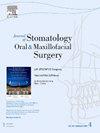Netrin 1 as a biomarker in cancer: scoping diagnostic, prognostic, and therapeutic perspectives with a focus on oral squamous cell carcinoma
IF 1.8
3区 医学
Q2 DENTISTRY, ORAL SURGERY & MEDICINE
Journal of Stomatology Oral and Maxillofacial Surgery
Pub Date : 2024-10-01
DOI:10.1016/j.jormas.2024.101982
引用次数: 0
Abstract
Goal of the review: The utilization of biomarkers to predict cancer risk, prognosis, and treatment outcomes is paramount. Netrin-1 (NTN1), known for its role in commissural axon guidance during embryonic development, has emerged as a versatile molecule with significant implications in cancer and neurobiology. Structurally resembling laminin, Netrin-1 regulates neuronal connectivity and plasticity in adulthood, influencing axonal and dendritic growth, neurotransmission, and cell migration. In addition to its neurological functions, Netrin-1 is increasingly recognized for its involvement in maintaining epithelial tissue and its regulatory roles in fundamental cellular processes, including adhesion, proliferation, differentiation, apoptosis, and angiogenesis.
In cancer biology, Netrin-1′s interactions with its receptors, such as DCC [Deleted in Colorectal Cancer] and UNC5 (a homolog of DCC), have been implicated in tumor progression across various physiological systems. Elevated levels of Netrin-1 in colorectal cancer and head and neck squamous cell carcinoma are correlated with increased tumorigenic potential, mediated through pathways involving NFκB activation and anti-apoptotic mechanisms. Mechanically induced hypermethylation and downstream signaling cascades that inhibit apoptosis and promote cell survival are observed upon Netrin-1 binding to DCC.
Furthermore, Netrin-1 shows promise as a biomarker for detecting inflammatory activity in diseases such as multiple sclerosis and as a potential diagnostic, prognostic, and therapeutic indicator in oral squamous cell carcinoma. Elevated levels of Netrin-1 in bodily fluids, alongside immunohistochemical evidence, support its potential as a valuable clinical marker in cancer management.
This abstract emphasizes Netrin-1′s diverse biological roles, underscoring its potential as a diagnostic tool and therapeutic target in cancer research. The need for further exploration of Netrin-1′s molecular interactions and clinical applications is urgent and crucial to advance personalized medicine approaches and enhance patient outcomes in oncology and neurology.
作为癌症生物标记物的内皮素 1:以口腔鳞状细胞癌为重点,探讨诊断、预后和治疗前景。
综述的目的:利用生物标志物预测癌症风险、预后和治疗效果至关重要。Netrin-1(NTN1)因其在胚胎发育过程中的神经轴突导向作用而闻名,现已成为对癌症和神经生物学有重要影响的多功能分子。Netrin-1在结构上类似于层粘蛋白,可调节成年期神经元的连接性和可塑性,影响轴突和树突的生长、神经传递和细胞迁移。除了神经功能外,Netrin-1 还参与维持上皮组织,并在粘附、增殖、分化、凋亡和血管生成等基本细胞过程中发挥调控作用,这一点正日益得到认可。在癌症生物学中,Netrin-1 与其受体(如 DCC [大肠癌中删除的受体] 和 UNC5(DCC 的同源物))的相互作用已被认为与各种生理系统的肿瘤进展有关。在结直肠癌和头颈部鳞状细胞癌中,Netrin-1 水平的升高与致瘤潜能的增加有关,它是通过涉及 NFκB 激活和抗凋亡机制的途径介导的。当 Netrin-1 与 DCC 结合时,可观察到机械诱导的高甲基化和抑制细胞凋亡、促进细胞存活的下游信号级联。此外,Netrin-1有望成为检测多发性硬化症等疾病中炎症活动的生物标记物,以及口腔鳞状细胞癌的潜在诊断、预后和治疗指标。体液中 Netrin-1 水平的升高以及免疫组化证据都支持其在癌症治疗中作为有价值的临床标记物的潜力。本摘要强调了 Netrin-1 的多种生物学作用,突出了其作为癌症研究中的诊断工具和治疗靶点的潜力。迫切需要进一步探索 Netrin-1 的分子相互作用和临床应用,这对推进肿瘤学和神经病学的个性化医疗方法和提高患者预后至关重要。
本文章由计算机程序翻译,如有差异,请以英文原文为准。
求助全文
约1分钟内获得全文
求助全文
来源期刊

Journal of Stomatology Oral and Maxillofacial Surgery
Surgery, Dentistry, Oral Surgery and Medicine, Otorhinolaryngology and Facial Plastic Surgery
CiteScore
2.30
自引率
9.10%
发文量
0
审稿时长
23 days
 求助内容:
求助内容: 应助结果提醒方式:
应助结果提醒方式:


